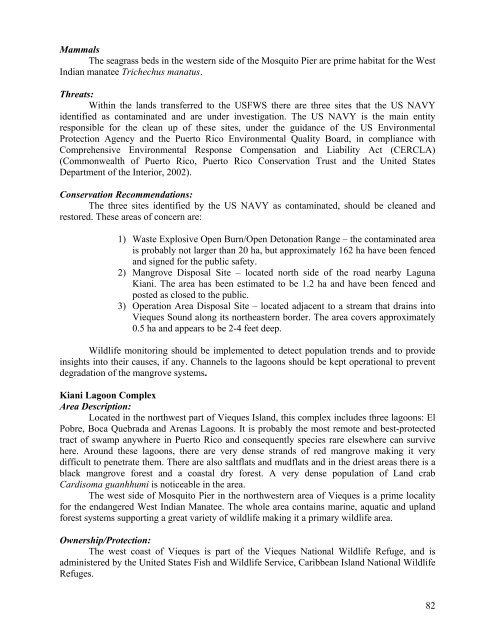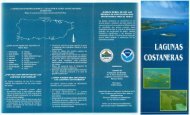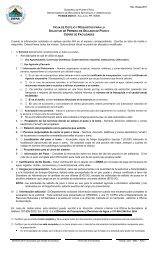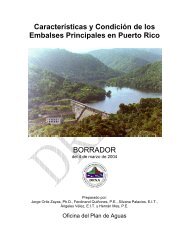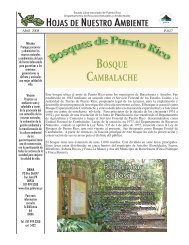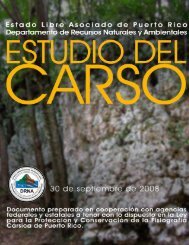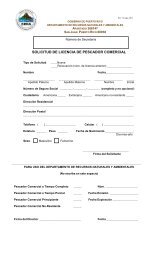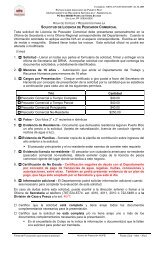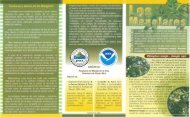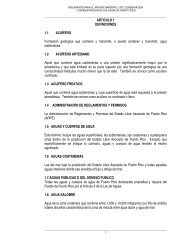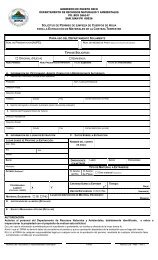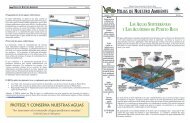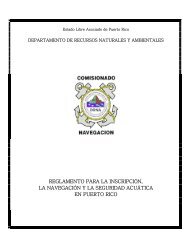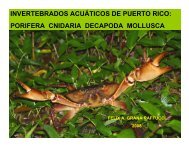Puerto Rico Critical Wildlife Areas - Puerto DRNA - Gobierno de ...
Puerto Rico Critical Wildlife Areas - Puerto DRNA - Gobierno de ...
Puerto Rico Critical Wildlife Areas - Puerto DRNA - Gobierno de ...
Create successful ePaper yourself
Turn your PDF publications into a flip-book with our unique Google optimized e-Paper software.
Mammals<br />
The seagrass beds in the western si<strong>de</strong> of the Mosquito Pier are prime habitat for the West<br />
Indian manatee Trichechus manatus.<br />
Threats:<br />
Within the lands transferred to the USFWS there are three sites that the US NAVY<br />
i<strong>de</strong>ntified as contaminated and are un<strong>de</strong>r investigation. The US NAVY is the main entity<br />
responsible for the clean up of these sites, un<strong>de</strong>r the guidance of the US Environmental<br />
Protection Agency and the <strong>Puerto</strong> <strong>Rico</strong> Environmental Quality Board, in compliance with<br />
Comprehensive Environmental Response Compensation and Liability Act (CERCLA)<br />
(Commonwealth of <strong>Puerto</strong> <strong>Rico</strong>, <strong>Puerto</strong> <strong>Rico</strong> Conservation Trust and the United States<br />
Department of the Interior, 2002).<br />
Conservation Recommendations:<br />
The three sites i<strong>de</strong>ntified by the US NAVY as contaminated, should be cleaned and<br />
restored. These areas of concern are:<br />
1) Waste Explosive Open Burn/Open Detonation Range – the contaminated area<br />
is probably not larger than 20 ha, but approximately 162 ha have been fenced<br />
and signed for the public safety.<br />
2) Mangrove Disposal Site – located north si<strong>de</strong> of the road nearby Laguna<br />
Kiani. The area has been estimated to be 1.2 ha and have been fenced and<br />
posted as closed to the public.<br />
3) Operation Area Disposal Site – located adjacent to a stream that drains into<br />
Vieques Sound along its northeastern bor<strong>de</strong>r. The area covers approximately<br />
0.5 ha and appears to be 2-4 feet <strong>de</strong>ep.<br />
<strong>Wildlife</strong> monitoring should be implemented to <strong>de</strong>tect population trends and to provi<strong>de</strong><br />
insights into their causes, if any. Channels to the lagoons should be kept operational to prevent<br />
<strong>de</strong>gradation of the mangrove systems.<br />
Kiani Lagoon Complex<br />
Area Description:<br />
Located in the northwest part of Vieques Island, this complex inclu<strong>de</strong>s three lagoons: El<br />
Pobre, Boca Quebrada and Arenas Lagoons. It is probably the most remote and best-protected<br />
tract of swamp anywhere in <strong>Puerto</strong> <strong>Rico</strong> and consequently species rare elsewhere can survive<br />
here. Around these lagoons, there are very <strong>de</strong>nse strands of red mangrove making it very<br />
difficult to penetrate them. There are also saltflats and mudflats and in the driest areas there is a<br />
black mangrove forest and a coastal dry forest. A very <strong>de</strong>nse population of Land crab<br />
Cardisoma guanhhumi is noticeable in the area.<br />
The west si<strong>de</strong> of Mosquito Pier in the northwestern area of Vieques is a prime locality<br />
for the endangered West Indian Manatee. The whole area contains marine, aquatic and upland<br />
forest systems supporting a great variety of wildlife making it a primary wildlife area.<br />
Ownership/Protection:<br />
The west coast of Vieques is part of the Vieques National <strong>Wildlife</strong> Refuge, and is<br />
administered by the United States Fish and <strong>Wildlife</strong> Service, Caribbean Island National <strong>Wildlife</strong><br />
Refuges.<br />
82


